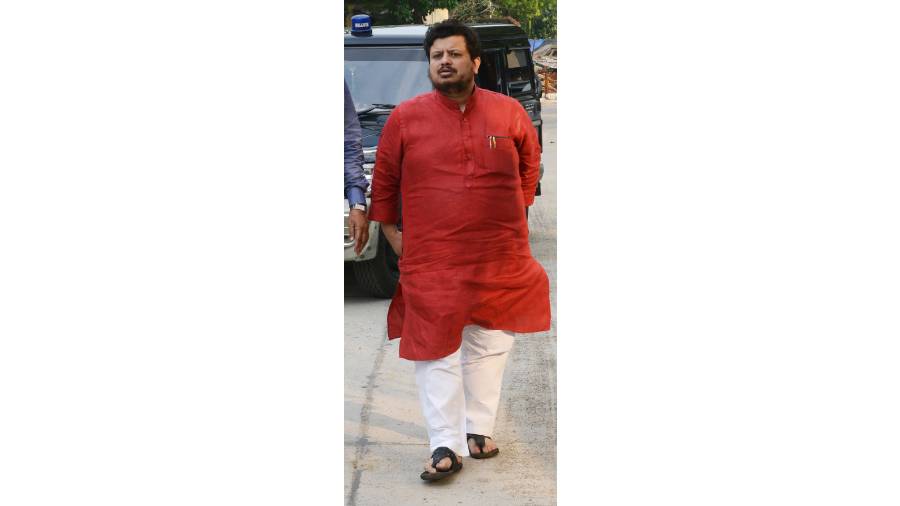Getting hold of Ritabrata Banerjee at a time of organisational ferment in the Trinamul Congress (TMC) is not easy. One moment he is holding a press conference, the next he is meeting trade union leaders or having one-on-one discussions with tea garden owners or industrial bigwigs. In between, he’s busy seeking blessings and guidance from senior party leaders. Banerjee, 42, has a new job; he was recently anointed state general secretary of the Indian National Trinamul Trade Union Congress or INTTUC.
The whisper is that the post was reward for his work in the tea gardens of north Bengal the past three years without any fanfare or hype. Banerjee says, “Ever since I joined the TMC in 2018, apart from other organisational work, the honourable chief minister asked me to focus on the tea gardens and tribal welfare in the area.” The assignment, he says, was cathartic.
Banerjee was with the CPI(M) till 2018, when he was expelled, allegedly for a lifestyle whose lavish ways didn’t sit well with communist ideology. He was also accused of womanising and speaking against top leaders of the party to the media.
Banerjee’s defence had been that he was a “victim of jealousy of leaders who always tried to malign” him. He also said, “Had I been dumb in Parliament, I would not have faced this fate.”
Bright, young and well-spoken, Banerjee’s meteoric rise in the CPI(M) had been the stuff of legend. He is said to have been mentored by the former chief minister of West Bengal, Buddhadeb Bhattacharya. And when he was sent up to Rajya Sabha at 34, there was a hubbub of disapproval in party circles.
It is said that cutting young leaders down to size is part of the CPI(M) house style. Dynamic young leaders such as Saifuddin Chowdhury, Prasenjit Bose and Jagmati Sangwan (Haryana) were expelled after each of them had a falling out with the party greybeards.
Within a month of his expulsion from the CPI(M), Banerjee was appointed convener of the newly-formed tribal welfare committee of the TMC. The primary task of the committee was to spot lapses in tribal welfare schemes and recommend suggestions for improvement, especially in the tea gardens of north Bengal that are inhabited by adivasis. I ask what his takeaway has been and he replies, “Mamata-i prakrita Bampanthi... Mamata Banerjee is the real Leftist leader.”
He continues, “The tea gardens had been languishing in abject poverty. She increased their daily wages from Rs 67 (in 2011) to Rs 202 (in 2020), introduced several revolutionary welfare schemes such as Chaa Sundari to improve their lot... Chaa Sundari is unique in India — not conceived even in the tea gardens of Kerala, a communist state.” The scheme is meant to provide housing for permanent tea garden workers.
The logical question is, despite all this, why did the TMC fare so poorly in the tea belt in this year’s Assembly elections? Especially in Alipurduar? Banerjee responds, “It’s true, but our vote share has significantly increased compared to the 2019 Lok Sabha polls.” He is confident that when the Chaa Sundari scheme is fully implemented, more people will be drawn towards the TMC.
Another challenge in the tea gardens, according to Banerjee, is bringing together the disparate unions under a single umbrella. There are 408 tea gardens across the districts of Darjeeling, Alipurduar and Jalpaiguri — and their workforce, comprising Gorkhas, Mundas and Oraons, is key to 16 Assembly seats. Banerjee is currently working towards knitting all the unions under the Trinamul Chae Bagan Shramik Union.
Though traditionally a Left bastion, the TMC grabbed all Assembly seats there in 2016. But in the 2019 Lok Sabha polls it lost all the seats to the BJP, which made a flurry of poll promises — promises that were ultimately never kept.
Speculation is that the BJP did well in 2019 because, among other things, a sizeable number of traditional Left votes shifted to its kitty. Those votes, Banerjee argues, are now turned TMC-wards. “It’s an irony that as the Left Front got decimated in the Assembly polls, Left-minded people started looking at Mamata Banerjee as a viable alternative leader.” He stresses that not just in Bengal, but nationally, the working class — farmers, industry workers and migrant labourers — feels only Mamata Banerjee can represent them and fight for their demands. “No wonder farmers fighting the draconian Farm Bill rallied beside her during the recent Assembly polls,” he adds.
Does he feel bad that his former party has no representation in the Bengal Assembly now? Banerjee responds, “The party is like the proverbial ostrich that kept its head buried in the sand amidst a desert storm. They started believing that they are the only contractors of Left ideology in India.”
Têtevitae
1978: Banerjee is born in Calcutta
1998: Begins political career as an activist of the Students’ Federation of India, the student wing of the CPI(M)
2008: Becomes all-India general secretary of the SFI
2011: Is chosen by the Left Front as its candidate for the by-elections to the Calcutta South Lok Sabha seat, which Mamata Banerjee vacated when she became the chief minister; loses to Subrata Bakshi of the TMC
2014: Is nominated to the Rajya Sabha
2018: Expelled from the CPI(M) and soon after joins the TMC
2021: Made the state general secretary of the INTTUC











